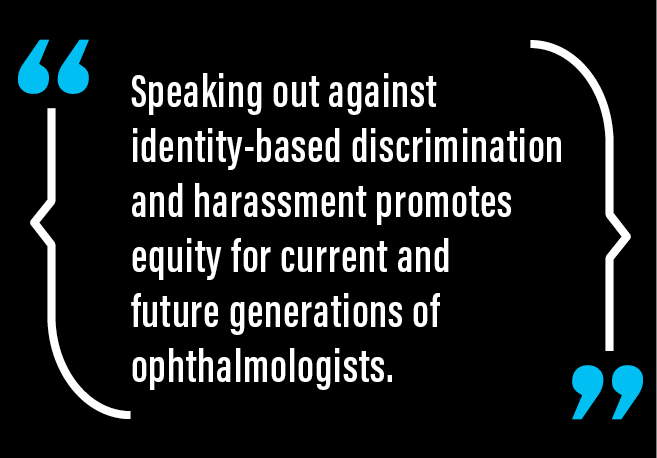A new patient is referred to your office for evaluation and, during the encounter, comments on how nice your legs look. When you ignore the comment, he tells you that he found your picture on the practice’s website and has been thinking about you at night.
For the past few weeks, a senior partner at your practice has been loitering around your workstation. It bothers you that he asks about your dating life, and you find yourself avoiding his company. The other day, he touched your buttocks. You want to file a complaint but worry about retaliation.
Experiences with workplace sexual harassment are highly prevalent among female ophthalmologists1 and ophthalmology trainees,2 but knowing how to identify and respond to harassment can be difficult. The US Equal Employment Opportunity Commission defines sexual harassment as “unwelcome sexual advances, requests for sexual favors, and other verbal or physical conduct of a sexual nature” that “explicitly or implicitly affects an individual’s employment, unreasonably interferes with an individual’s work performance, or creates an intimidating, hostile, or offensive work environment.” Most employers are required to have policies in place for dealing with harassment by supervisors and colleagues, but guidelines for dealing with sexual harassment by patients can be vague or nonexistent.
It is important to recognize that sexual harassment is rooted in the assertion of power by the harasser, rather than in sexuality. Taking action against harassment helps create a workplace culture that does not tolerate harassment of employees at any level—from technicians and front-desk staff to senior partners. Fortunately, there are training resources available to help you and your colleagues respond to inappropriate behavior, with a spectrum of responses based on severity.
Patient-Initiated Verbal Sexual Harassment
It can be tempting to ignore inappropriate behavior from patients, especially if it does not affect your ability to continue providing their care. However, recurrent gender-based inappropriate behavior, even from patients, has known negative impacts on staff, ranging from decreased work satisfaction to increased stress and mental illness.2 Disrupting the harasser’s behavior can prevent the victimization of others. It helps to have a response script rehearsed to avoid freezing in the moment.
The University of Iowa Toolkit for Responding to Patient-Initiated Verbal Harassment3 lists several communication strategies for responding to harassment toward oneself and others. One strategy is to acknowledge the perpetrator’s good intentions, explain how the behavior makes you feel, and focus on professionalism. For example: “I know you probably didn’t mean anything by it, but I feel uncomfortable when you comment on my appearance. I want to give you the best care that I can, so let’s keep our conversation professional.”

In cases of persistent or severe harassment, it is important to keep a written record with details of the events, should you decide to escalate your response. Options for escalation include firing the patient from your practice and reporting the patient to hospital authorities or law enforcement. Ophthalmology departments or practices looking to improve their ability to address harassment by patients can download an Association of American Medical Colleges workshop4 that includes open-access materials for rehearsing responses to verbal harassment.
Verbal and/or Physical Sexual Harassment by a Colleague/Supervisor
The AAO’s Code of Ethics describes discrimination and harassment as “likely to jeopardize patient care, exploit inequalities in status or power, and abuse the trust placed in us as ophthalmologists,” with potential consequences including termination of membership. All practices should have a sexual harassment policy that includes annual training. Training should focus on sincere efforts to prevent incidents of harassment, rather than just policy compliance. Practices should also have a mechanism to investigate complaints, sometimes with an outside firm if needed. Finally, practice owners should obtain Employment Practices Liability Insurance to cover lawsuits related to sexual harassment and other suits brought by employees.
Incidents of serious verbal and/or physical sexual harassment by a supervisor should be directly responded to, recorded, and reported. Although would-be reporters are legally protected from retaliation, many fear covert consequences such as loss of mentorship, research support, or job opportunities.5 Although these risks may be real, failure to report an incident may put future colleagues, trainees, or staff at risk of further harassment behavior. Because perpetrators of sexual harassment tend to be repeat offenders, one person’s report may serve as key support for another victim. Finally, speaking out against identity-based discrimination and harassment promotes equity for current and future generations of ophthalmologists.
CONCLUSION
Sexual harassment is common; all ophthalmologists should anticipate that it will affect them or their staff, colleagues, or trainees. It is important to know your employer’s policy on reporting harassment and have a plan for how you will respond in the moment so that you are prepared. By openly discussing workplace harassment, we as a profession can move past the culture of silence and shame to improve the personal and professional experiences of future ophthalmologists.
1. Cabrera MT, Enyedi LB, Ding L, MacDonald SM. Sexual harassment in ophthalmology: a survey study. Ophthalmology. 2019;126(1):172-174.
2. Scruggs BA, Hock LE, Cabrera MT, Wang K, et al. A U.S. survey of sexual harassment in ophthalmology training using a novel standardized scale. J Acad Ophthalmol. 2020;12(01):e27-e35.
3. Hock LE, Scruggs BA, Oetting TA, Abramoff MD, Shriver EM. Tools for responding to patient-initiated verbal sexual harassment. Updated August 20, 2019. Accessed August 2, 2020. https://EyeRounds.org/tutorials/sexual-harassment-toolkit/index.htm
4. Hock LE, Barlow PB, Scruggs BA, et al. Tools for responding to patient-initiated verbal sexual harassment: a workshop for trainees and faculty. MedEdPORTAL. 2021;17(11096).
5. Binder R, Garcia P, Johnson B, Fuentes-Afflick E. Sexual harassment in medical schools: the challenge of covert retaliation as a barrier to reporting. Acad Med. 2018;93(12):1770-1773.




